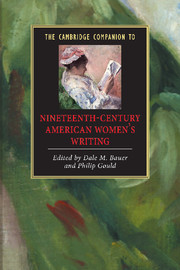Book contents
- Frontmatter
- Introduction
- Part I Historical and theoretical background
- Part 2 Genre, tradition, and innovation
- 4 Captivity and the literary imagination
- 5 Nineteenth-century American women's poetry
- 6 Women at war
- 7 Women, anti-Catholicism, and narrative in nineteenth-century America
- 8 Immigration and assimilation in nineteenth-century US women's writing
- Part 3 Case studies
- Conclusion
- Index
7 - Women, anti-Catholicism, and narrative in nineteenth-century America
from Part 2 - Genre, tradition, and innovation
Published online by Cambridge University Press: 28 May 2006
- Frontmatter
- Introduction
- Part I Historical and theoretical background
- Part 2 Genre, tradition, and innovation
- 4 Captivity and the literary imagination
- 5 Nineteenth-century American women's poetry
- 6 Women at war
- 7 Women, anti-Catholicism, and narrative in nineteenth-century America
- 8 Immigration and assimilation in nineteenth-century US women's writing
- Part 3 Case studies
- Conclusion
- Index
Summary
Where was religion in nineteenth-century American women's writing? Everywhere. Especially with the ideological shift from a patriarchal-centered Calvinism to a more “feminized” nonsectarian Protestantism (see works cited below: Cott, Douglas, Sklar), women were given warrant to write on religious matters. At times, this writing took the form of overtly theological texts, some conventionally pious, others, like Mary Baker Eddy's 1875 Science and Health and Elizabeth Cady Stanton's 1895 The Woman's Bible, radical and revolutionary. More widespread was the way that religion as a topic pervaded virtually every genre of women's (and for that matter men's) writing from Sarah Grimké's abolitionist An Epistle to Christian Women of the South (1836) to Emily Dickinson's intensely spiritual - and skeptical - poetry.
Perhaps the most striking component of nineteenth-century religious writing was the development and proliferation of religious fiction. In 1871, Harriet Beecher Stowe described the current craze for narratives that “teach[] by parables”:
It is now understood that whoever wishes to gain the public ear, and to propound a new theory, must do it in a serial story. Hath any one in our day, as in St. Paul’s, a psalm, a doctrine, a tongue, a revelation, an interpretation – forthwith he wraps it up in a serial story, and presents it to the public . . . We have Romanism and Protestantism, High Church, and Low Church and no Church, contending with each other in serial stories, where each side converts the other, according to the faith of the narrator.
(My Wife and I, 2)- Type
- Chapter
- Information
- Publisher: Cambridge University PressPrint publication year: 2001



